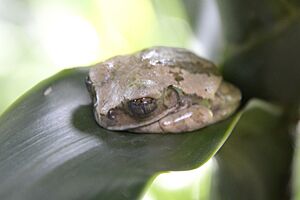Leptopelis flavomaculatus facts for kids
Quick facts for kids Leptopelis flavomaculatus |
|
|---|---|
 |
|
| Yellow-spotted tree frog in the greenhouse of MUSE - Science Museum in Trento | |
| Conservation status | |
| Scientific classification | |
| Synonyms | |
|
Hyperolius flavomaculatus Günther, 1864 |
Leptopelis flavomaculatus is a fascinating type of frog that belongs to the Arthroleptidae family. You can find this frog in the lowlands of eastern and southern Africa. Its home stretches from Mozambique (north of the Save River) and Zimbabwe all the way to Malawi, eastern Tanzania (including the island of Zanzibar), and the coast of Kenya. People call it by many names, like the yellow-spotted tree frog, brown-backed tree frog, brown forest treefrog, or Johnston's treefrog.
Contents
About the Yellow-Spotted Tree Frog
What Does It Look Like?
Adult male yellow-spotted tree frogs are about 44 to 50 millimeters long. That's about the size of a large paperclip! Female frogs are bigger, measuring 60 to 70 millimeters.
Their back, called the dorsum, can be either a solid green with white heels, or brown. If it's brown, it often has a darker, triangle-shaped pattern pointing forward. They also have a dark line between their eyes and another dark line along their snout. Young frogs that are green often have bright yellow spots, which is how they get their common name!
This frog looks a bit like another frog called Leptopelis vermiculatus, but it doesn't have the worm-like patterns on its back. It's also similar to L. christyi, but the yellow-spotted tree frog is larger.
Where Does It Live?
The yellow-spotted tree frog loves to live in lowland and mountain evergreen forests. It especially likes dry forests. You can find them at elevations up to 1,600 meters above sea level.
These frogs live in both untouched forests and areas where the forest has grown back after being disturbed. They often stay near streams. However, they cannot survive in open areas outside of the forest. Male frogs like to call out from leaves or branches, often about 3 to 4 meters high. They might also call from the entrance of burrows in the ground. Like other frogs in its group, it's thought that the female lays her eggs in a nest close to water.
Protecting This Frog
The yellow-spotted tree frog is often common in places where it can find suitable homes. However, its habitat is shrinking. This is due to things like farms expanding, trees being cut down for wood, and more human settlements. These activities threaten the frog's natural home. Luckily, this frog lives in several protected areas, which helps keep it safe.
Frog Family Tree
The yellow-spotted tree frog, Leptopelis flavomaculatus, was first described by a scientist named Albert Günther in 1864. He studied a young frog specimen to identify it. This frog's closest relative is another frog called Leptopelis christyi. Some scientists also think that Leptopelis lebeaui might be the same species as L. flavomaculatus.


